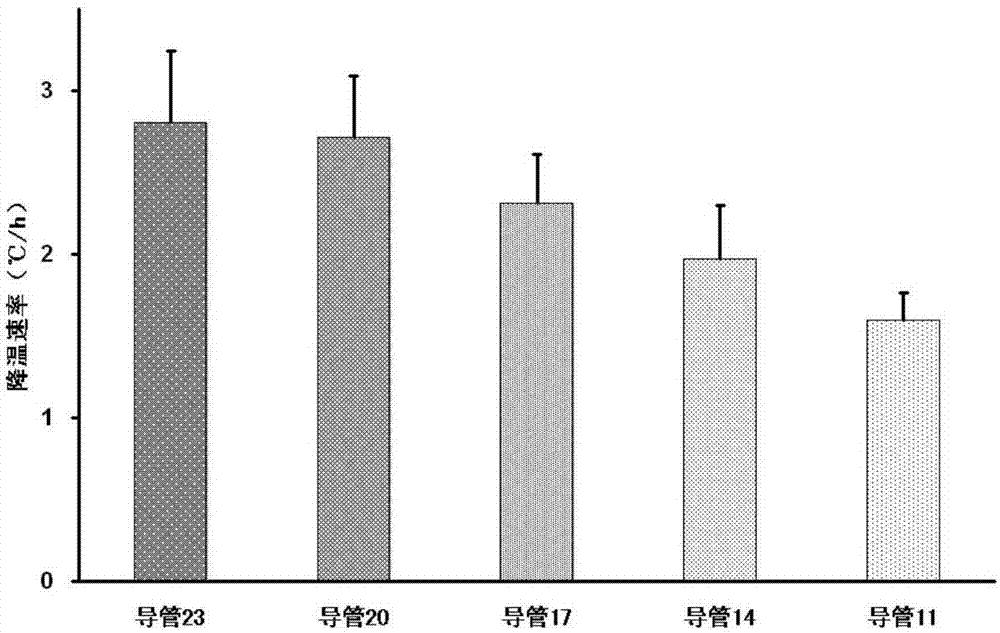Animal blood temperature lowering method and application thereof and cardiopulmonary resuscitation low temperature animal model preparing method and animal model
A cardiopulmonary resuscitation and animal model technology, applied in the medical field, can solve the problems of high cost, slow cooling speed, and poor effect, and achieve the effect of low cost, fast cooling speed, and simple operation
- Summary
- Abstract
- Description
- Claims
- Application Information
AI Technical Summary
Problems solved by technology
Method used
Image
Examples
Embodiment 1
[0065] This embodiment provides a method for inducing animal blood cooling through the esophagus, including: after fixing the animal, the esophageal cooling catheter is externally connected to an ice blanket instrument, the esophageal cooling catheter is inserted into the esophagus of the animal, and the esophageal cooling catheter is perfused with a circulating low-temperature liquid at 4°C , through heat exchange between the 4°C liquid and the blood in the heart and large blood vessels adjacent to the esophagus, the purpose of rapid cooling is achieved.
[0066] Wherein, the 4°C liquid may be, for example, but not limited to: 4°C sterilized water for injection.
[0067] The esophageal cooling catheter used in Example 1 is as follows: figure 1 As shown, the esophageal cooling catheter includes a central part 1 and a helical part 2 that is attached to the central part 1 and spirally arranged. This arrangement ensures the maximum contact area between the esophageal cooling cath...
Embodiment 2
[0088] This embodiment provides a method for preparing a hypothermic animal model of cardiopulmonary resuscitation, including:
[0089] 1. Experimental animal preparation
[0090] 1) Before the experiment, the animals were fasted for 12 hours without water.
[0091] 2) During the experiment, anesthesia was induced by intramuscular injection of ketamine at 20 mg / kg, weighed, placed on the triangle of the operating table, fixed the limbs, and connected to the SPO 2 , ECG and rectal watch, dynamic monitoring of vital signs, and use temperature control blanket to maintain normal body temperature of animals at (38.0±0.5)℃ before induction of ventricular fibrillation.
[0092] 3) Establish ear vein channel, general anesthesia with pentobarbital sodium 30mg / kg intravenously, then maintain anesthesia state with pentobarbital sodium 8mg / (kg·h), and continue sedation with fentanyl 2μg / (kg·h) pain treatment.
[0093] 4) Orotracheal intubation, connected to ETCO 2 / SPO 2 Monitor and ve...
Embodiment 3
[0119] This example provides a method for cooling animal blood induced by CRRT, including: using CRRT to introduce venous blood to the outside of the body, and then placing the CRRT venous return line in 4°C liquid to realize blood and 4°C liquid passing through CRRT The pipeline performs rapid heat exchange, and then the low-temperature blood is returned to the body to achieve the purpose of rapid cooling.
[0120] Among them, CRRT parameter setting:
[0121] In CVVH mode, the blood flow rate is initially 180ml / min and maintained at 120ml / min, the rate of replacement fluid is 30ml / kg / h, dehydration is 0ml / kg / h, the first dose of heparin is injected statically at 1000U, and the micropump maintains at 150U / h.
[0122] CRRT liquid configuration:
[0123] Preflush: 1 tube of heparin, 1500ml of 0.9% NaCl solution.
[0124] Replacement solution: 1) A solution: 0.9% NaCl solution 2000ml, 5% Glu solution 100ml, 10% KCl solution 10ml, 10% calcium gluconate solution 13ml, 25% MgSO 4...
PUM
 Login to View More
Login to View More Abstract
Description
Claims
Application Information
 Login to View More
Login to View More - R&D
- Intellectual Property
- Life Sciences
- Materials
- Tech Scout
- Unparalleled Data Quality
- Higher Quality Content
- 60% Fewer Hallucinations
Browse by: Latest US Patents, China's latest patents, Technical Efficacy Thesaurus, Application Domain, Technology Topic, Popular Technical Reports.
© 2025 PatSnap. All rights reserved.Legal|Privacy policy|Modern Slavery Act Transparency Statement|Sitemap|About US| Contact US: help@patsnap.com



